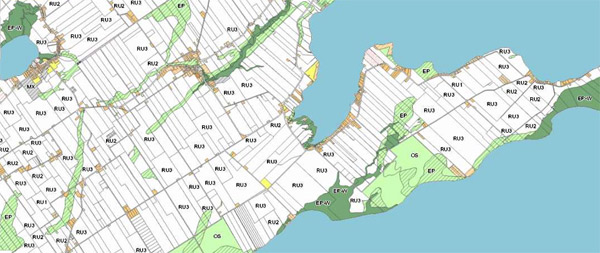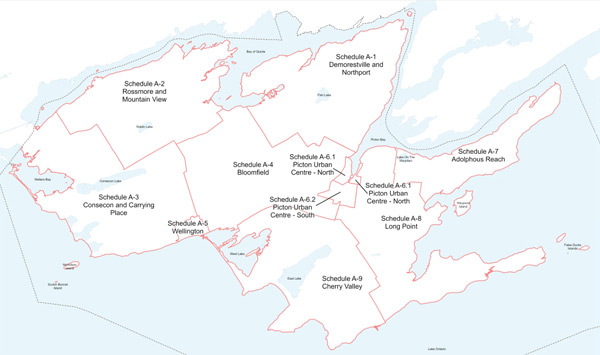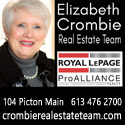Revised zoning bylaw outlines how property owners can develop their property
Administrator | Apr 03, 2025 | Comments 0
By Sharon Harrison
A revised 395-page Comprehensive Zoning Bylaw document, which sets out rules for how land in Prince Edward County is used and developed, was presented to council Wednesday evening at the planning and development committee meeting.
Property owners are encouraged to familiarize themselves with it, especially if they are intending to develop their property at some point, as it also relates to:
-constructing a new home or building
-adding an additional dwelling unit(s)
-changing the use of the property (i.e. from commercial to residential)
-severing a portion of the property
-building an addition, such as an extension to a house or attached garage, or an accessory structure (detached garage, shed or gazebo)
-adding a porch or deck.
It contains some important changes and is intended to help residents understand what is permitted for development, and how development may take place on a resident’s property, as well as the implications for development.
Under a new two-step planning meeting process (effective Jan. 1), there is no decision, discussion or debate by council at this first meeting. Decision comes at a future second statutory public meeting (expected in June) where staff will provide a report and recommendation to adopt.
 Residents should be aware that rural 1 (RU1), rural 2 (RU2) and rural 3 (RU3) zones are proposed to be consolidated into one single rural (RU) zone.
Residents should be aware that rural 1 (RU1), rural 2 (RU2) and rural 3 (RU3) zones are proposed to be consolidated into one single rural (RU) zone.
In her presentation, project consultant Nadia De Santi with WSP, provided an overview of the bylaw changes. Five members of the public, specifically winery operators and farmers, raised issues pertaining to the proposed framework surrounding winery and agricultural operations, describing them as limiting and restrictive land use provisions.
Di Santi also noted daycare centres and private home daycares have been added as a permitted use more broadly, indicating that daycare centres are permitted in most commercial zones, with private home day cares permitted in most residential zones.
Councillor Brad Nieman asked what “most commercial zones” meant, as Michael Michaud (County’s manager of planning) clarified that daycare centres are permitted in UC (urban commercial), GC (general commercial), LC (local commercial) and TC (tourist commercial) zones.
“I have been harping that any new development, if there’s a commercial block, that’s going to allow for the daycare, is that my understanding?” asked Nieman. Michaud said that was correct. “As a plan of sub-division comes through with commercial block, typically anything in a residential area would have an LC zone, and in that zone daycares are permitted.”
Michaud confirmed that a home-based business (daycare) can exist in a residential area, and is permitted in all residential zones, for no more than five children.

A revised set of zoning schedules (i.e., maps) have been prepared to illustrate where zones are applied.
Amy Bodman, representing the Prince Edward County Field Naturalists, acknowledged that some of the group’s suggestions (along with those from the South Shore Joint Initiative) have been incorporated into the revised comprehensive zoning bylaw, but others have not been addressed.
“In our previous comments, we suggested that some definitions be added, and we specifically suggested definitions for major development, natural core areas, and woodlands,” expressed Bodman. “We continue to believe that these and other definitions (for example, natural core area linkages and natural heritage system) are needed to provide more clarity to proponents.”
Bodman noted that in their previous comments some new sections be included in section 3.31, also outlining that section 3.315 deals with development adjacent to provincially-significant wetlands, where they had requested that new sections be added, as follows:
(1) Development adjacent to wetlands, other; (2) development adjacent to significant woodlands; (3) development adjacent to significant valley lands; (4) development adjacent to significant wildlife habitat and fish habitat; and (5) development adjacent to areas of significant natural and scientific interest.
“Many of the provisions in section 3.31 note the requirement for an environmental impact study. We request that a section be added to clarify that an EIS shall only be approved by the County if the study is completed according to the terms of reference and submission standards.”
Further, Bodman quoted section 3.25E (public uses and utilities) where she indicated they do not agree that stormwater management facilities should be permitted in environmental protection and environmental protection-wetland zones.
First adopted in 2006, a re-draft of the existing comprehensive zoning bylaw is required by the planning act, given the approval of the new (2021) official plan. Proposed zoning bylaw changes include new and updated definitions, the introduction of an agricultural zone, the as-of-right permission for on-farm diversified uses (OFDUs), along with the consolidation of and reduction in the number of exception zones.
Further, new definitions have been added for additional dwelling unit, dwelling, townhouse (back-to-back and stacked), development, and electric vehicles. Also, community garden, agriculture-related use, cidery, distillery or micro-brewery, agri-tourism use, and on-farm diversified use, among them.
Provisions for wineries have also been updated to define an estate winery or a farm winery as a winery, with updated winery definitions to include on-farm diversified use(s) and a tied house. The new tied house definition means an accessory use for a winery, cidery and brewery where alcoholic beverages are produced on-site and food is offered.
A new agricultural zone (AG) is also proposed and is intended to implement the policies of the agricultural area designation in the official plan, to include properties that may be currently zoned RU1, RU2, RU3 and other zones. Permitted used under the new zone will include on-farm diversified uses and agriculture-related uses.
A minimum lot size of 40 hectares is proposed to be required in the new AG zone. However, non-complying property with existing lots smaller than 40 hectares will be considered as legally non-complying, with uses existing permitted to continue as is.
Agriculture-related uses are those uses that directly relate to farm operations, but not necessarily on a farm, such as a farmers’ market, farm equipment repair shop, seed or fertilizer supplier, processing of produce grown in the area, and wineries.
On-farm diversified uses are defined as secondary to the main agricultural use on a property and are limited in areas. They include things such as home industries (such as welding and woodworking), agri-tourism, home occupations, value-added uses ( selling/retail of products produced through the agricultural use), and recreation. OFDU operations must not exceed a total of one hectare (or two percent) of the lot area.
Documentation related to the comprehensive zoning bylaw final draft (including the final draft, study, maps etc.), can be found on the County’s website, Have Your Say portal, which outlines all stages of the process since it began in February 2023.
Filed Under: Featured Articles • Local News
About the Author:
































